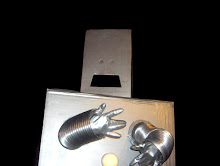 Ad school taught me some weird things, and one was that the human eye does a backwards Z across any page it reads, skimming along, hoping to be stimulated, becoming disappointing and trying again on the next page. According to the hard working folks at Eyetrack, it does something more like this:
Ad school taught me some weird things, and one was that the human eye does a backwards Z across any page it reads, skimming along, hoping to be stimulated, becoming disappointing and trying again on the next page. According to the hard working folks at Eyetrack, it does something more like this:
In actuality, that's a graph of web usage, but it still illustrates the idea that your eye is a skeevy fool who can't be trusted to look at a piece of paper by itself. Who am I to compare the analysis of a closet alcoholic to the practically Skynet-like scrutiny of Eyetrack's creepy machines? Let's focus on it's troubling figures on headlines to start.
First, a giant, domineering headline immediately draws the eye. Wait, don't bail. The numbers show that the average person gives that headline less than one seconds worth of facetime. Not even an entire whole second will be spent on your headline. How are you going to drag them into the depth of your body copy if their brain shuts off after "Call me Ishmael"? Provoke. People are likely to continue reading after the first five words if those first five words provoke their interest. Look at your headline an ask yourself how can it work harder?
Now let's look at that body copy. This eye-eating abomination (not sure exactly how it functioned) suggests that smaller type size encourages focused viewing behaviour while giant large type encourages scanning. Also shorter paragraphs tracked better in research than longer ones. Ever been on a date with a chatty drunk? They're not that much fun. So why are you philabustering on your layout. Learn to trim the fat. Just the facts. Snag the eye. Drive them to the web for more information. Sites like Lowbrow and One Sentence have always been great for understanding the need for berevity in story telling. Twitter is another great disciplinary tool for staying on point and keeping it short.
A copywriter friend of mine once went on a drink with a chatty drunk who refered to copywriting as "all that stuff between the headline and the logo". Technically, she might have been right. Let me welcome you to the end of this entry. I appreciate it, regardless of what weird path your eye took to get here. Oh, and your eye is not filled with a kind of urine.








